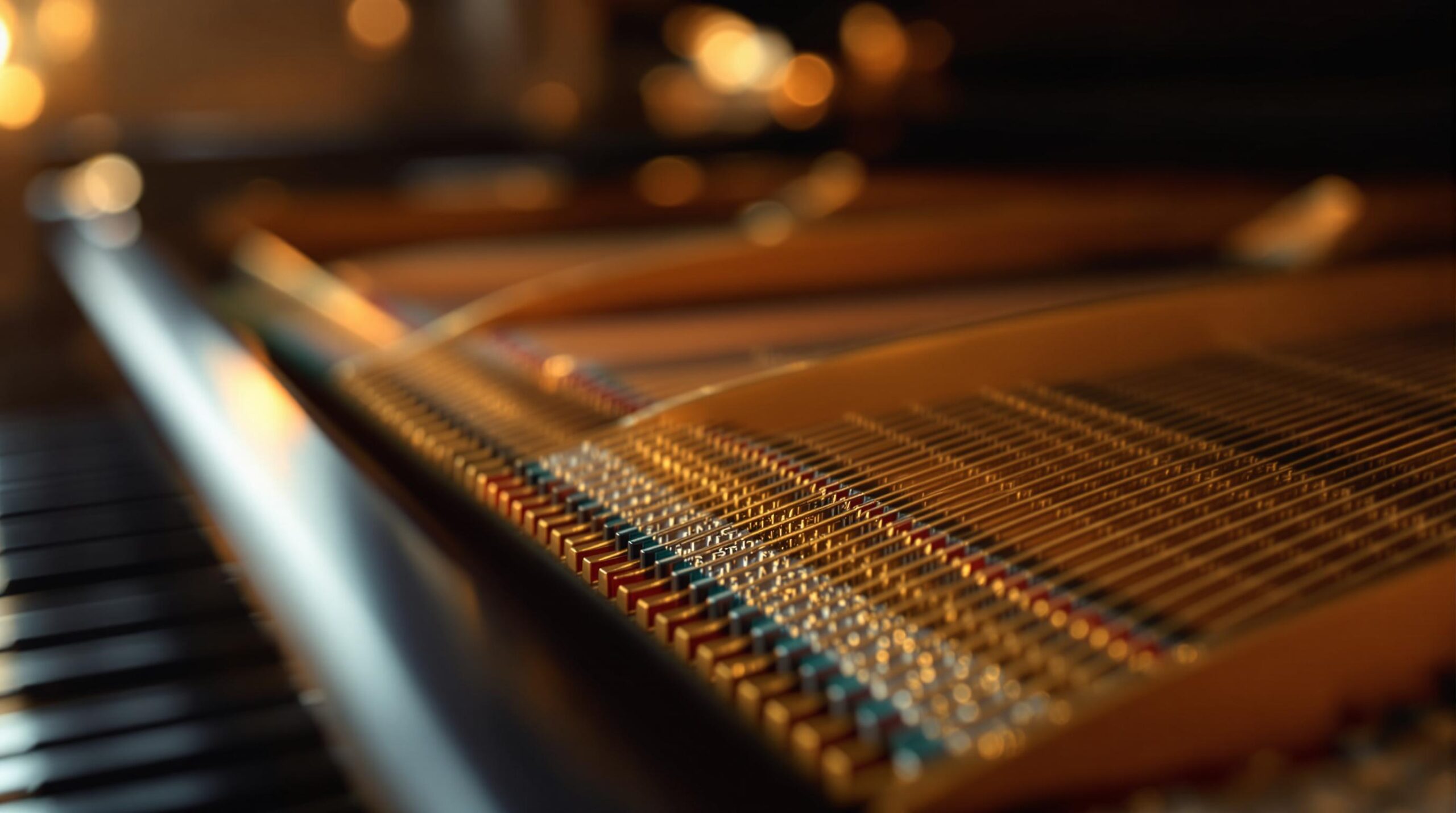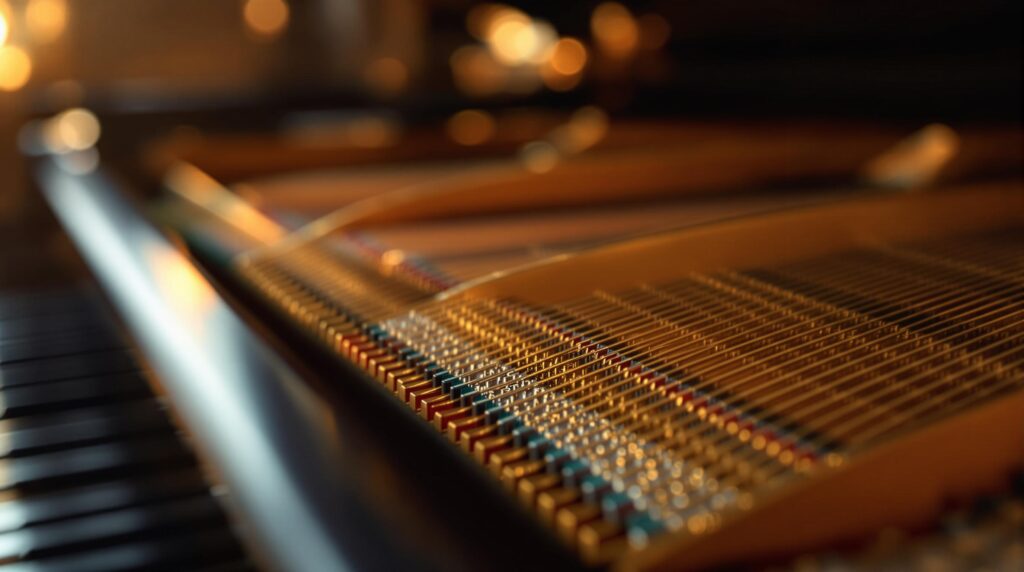
When it comes to piano sound, string materials play a crucial role. Here’s what you need to know:
- Steel Strings: Found in the treble and mid-range, they produce bright, clear tones with strong projection.
- Copper-Wrapped Bass Strings: Used in the bass, they deliver warm, resonant tones with extended sustain.
Key Factors:
- Sound Quality: Steel emphasizes brightness, while copper adds warmth.
- Sustain: Copper strings vibrate longer, creating richer bass tones.
- Durability: Steel strings are more resistant to wear, but copper-wrapped strings need regular care.
Quick Comparison:
| String Type | Tone | Sustain | Durability |
|---|---|---|---|
| Steel (Treble/Mid) | Bright, clear | Shorter | High |
| Copper-Wrapped Bass | Warm, resonant | Longer | Moderate |
Proper maintenance, such as tuning, cleaning, and controlling the environment, ensures your piano strings last longer and sound their best.
Piano Music Wire – Types, Sizes And Uses I HOWARD PIANO …
Piano String Materials Today
Modern piano strings combine traditional craftsmanship with advanced metallurgy to create a balanced and dynamic tone. Here’s a closer look at how these materials shape the sound of each register.
Steel Strings: Treble and Mid-Range Essentials
Treble and mid-range strings are crafted from high-carbon steel, a type of music wire known for its strength, elasticity, and durability. This material produces bright, clear overtones, giving the piano its brilliance and clarity in the higher registers.
Bass Strings: Copper-Wrapped Design
Bass strings are constructed with a steel core wrapped in a thin copper wire. This design adds mass while maintaining flexibility, which is essential for producing low frequencies. The added mass enhances the depth of the tone, while flexibility helps create richer overtones and manage vibrations effectively.
| Property | Impact on Sound |
|---|---|
| Increased Mass | Enables lower frequencies without requiring longer strings |
| Flexibility | Enhances the richness of bass overtones |
| Vibration Control | Produces clear, sustained bass tones |
These specific properties highlight how copper and steel work together to shape the piano’s bass sound.
Steel vs. Copper: A Contrast in Tone
Steel strings dominate the upper registers with their bright, focused tones, while copper-wrapped bass strings provide a warm, resonant foundation. Together, they create the piano’s full and dynamic tonal range.
Sound Effects of String Materials
Let’s dive deeper into how string materials influence the sound of a piano. The material used in piano strings plays a key role in shaping the sound waves they produce and sustain. This relationship is why specific materials are chosen for different registers.
Sound Wave Patterns
The composition of a string directly impacts how it vibrates. Steel strings, for example, produce consistent wave patterns that result in clear and focused fundamental tones. These vibrations span a wide range of frequencies, giving each string its unique sound.
When a piano key is struck, the string’s material affects three key aspects of the sound:
- Initial Attack: The sharp, immediate response when the key is pressed.
- Sustain Quality: The ability of the string to retain vibrations, influenced by its density.
- Harmonic Profile: The emphasis on overtones, determined by the string’s composition.
Here’s a quick comparison of how different string types behave:
| String Type | Wave Pattern | Tonal Character |
|---|---|---|
| Plain Steel | Linear, uniform | Bright, focused |
| Copper-Wrapped | Layered | Warm, resonant |
| Bass Strings | Multi-dimensional | Rich, sustained |
These patterns directly affect how each note resonates and contributes to the piano’s overall sound.
Sound Duration
The material of a string also influences how long a note lasts. Several factors come into play:
- Material Density: Denser materials tend to sustain vibrations for a longer time.
- Internal Friction: Steel strings, with lower internal friction, produce a cleaner decay.
- Cross-sectional Area: Thicker strings have longer-lasting fundamental tones.
The impact of these factors varies across the piano’s registers:
| Register | Sustain Quality | Decay Pattern |
|---|---|---|
| Treble | Brief sustain | Quick initial decay |
| Mid-range | Moderate sustain | Gradual, even decay |
| Bass | Prolonged sustain | Extended resonance |
The combination of string materials and the interaction with the piano’s soundboard creates the instrument’s characteristic balance of quick response and lasting resonance. This interplay is what gives the piano its rich and dynamic sound.
sbb-itb-b8bc1ab
Selecting Piano String Materials
Choosing the right materials for piano strings is crucial for achieving balanced sound quality and ensuring durability. Here’s what to keep in mind when making your selection.
Key Factors to Consider
When deciding on piano string materials, pay attention to these aspects:
- Tonal Range: Steel strings are ideal for bright, treble notes, while copper-wrapped strings deliver deeper, warmer tones for the bass.
- Tension Capacity: Each register has specific strength requirements, so select materials that can handle the necessary tension.
- Sound Quality: Aim for a balance between the crisp tones of steel and the rich resonance of copper-wrapped strings.
- Responsiveness: Consider how the strings perform under various playing dynamics across the piano’s range.
The choice of materials should also complement the piano’s size, the player’s style, and the acoustics of the performance space.
Caring for Your Strings
Once you’ve selected the best materials, proper care is essential to maintain their performance and extend their lifespan.
Different materials have unique maintenance needs. Steel strings typically retain their tonal clarity for longer periods, while copper-wrapped strings may need attention sooner. Factors like how often the piano is played and environmental conditions also play a role in string longevity.
Here’s how to keep your strings in top condition:
- Control the Environment: Keep the piano in a stable environment with consistent temperature and humidity to reduce stress and prevent corrosion.
- Regular Tuning: Schedule professional tuning sessions to maintain balanced sound and proper tension.
- Routine Cleaning: Use a soft, dry microfiber cloth to gently clean the strings, preventing oxidation and buildup.
Frequent inspections can help catch early signs of issues, such as unwinding in copper-wrapped strings, surface corrosion, tension imbalances, or metal fatigue.
For expert advice on choosing and maintaining piano strings, Cooper Piano offers professional services to ensure your instrument stays in excellent condition.
Next, we’ll look at advancements in modern piano string materials.
New String Material Developments
Piano string technology continues to evolve, enhancing both tone and performance by building on traditional materials and manufacturing techniques.
Modern String Materials
Recent advancements focus on improving durability and sound quality. Traditional steel core strings have been upgraded with micro-alloyed steel, offering better tensile strength and resonance.
A notable development is the use of carbon-fiber reinforced strings. These hybrid strings, combining a steel core with carbon fiber, provide several benefits:
- Enhanced tension stability
- Resistance to environmental factors
- Improved tuning consistency
- Reduced metal fatigue over time
Protective coatings have also advanced significantly. Nickel-chrome plating now offers better corrosion resistance while preserving tonal clarity. Some manufacturers are also adopting ultra-thin vacuum-deposited coatings, which protect strings without affecting vibration or sound quality.
These advancements mark an exciting step forward in piano string technology.
What’s Next for Piano Strings
Research is exploring new possibilities to further improve piano strings:
Composite Materials: Advanced composites are being developed to combine the strengths of steel and copper strings. These materials aim to deliver:
- Longer sustain
- Balanced overtones
- Better tuning stability
- Reduced environmental impact
Smart Materials: Cutting-edge technologies are introducing strings with embedded sensors capable of:
- Monitoring tension in real-time
- Alerting users to tuning issues
- Tracking wear and performance
- Supporting maintenance scheduling with data insights
Manufacturing Innovations: New methods in winding, metallurgy, and quality control are being tested to ensure consistent performance across strings.
If you’re curious about how these advancements might affect your piano, Cooper Piano’s technicians can assess your instrument’s string condition and provide expert advice.
Conclusion: String Material Basics
How Materials Shape Sound
Understanding string materials is crucial for achieving the best sound from your piano. For instance, steel cores paired with copper-wrapped bass strings create a rich, nuanced tone.
Here’s a quick breakdown of their characteristics:
- Steel Strings: Deliver a bright, focused sound.
- Copper-Wrapped Bass Strings: Add warmth and depth.
Beyond tone, string materials also affect sustain, tuning stability, and how responsive the instrument feels. These factors all play a role in shaping your piano’s overall performance.
What to Do Next
For expert advice on string selection and maintenance, reach out to Cooper Piano’s technicians. With over a century of experience, they offer personalized recommendations to help you care for your piano. Regular upkeep and proper string care are vital for maintaining sound quality and extending the life of your instrument.
"At Cooper Piano we pride ourselves on the quality of our products" – Cooper Piano [1]
Use these insights to enhance your piano’s sound and performance.

